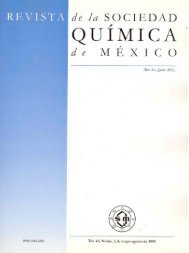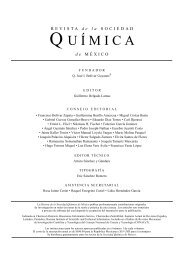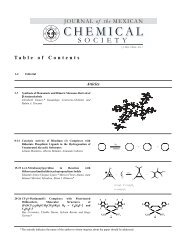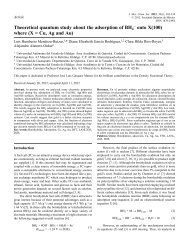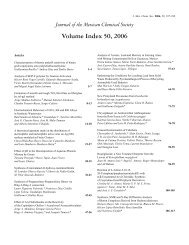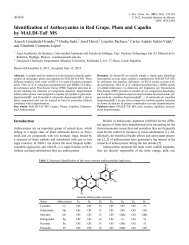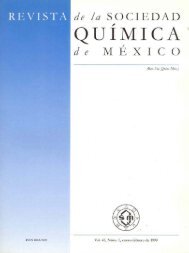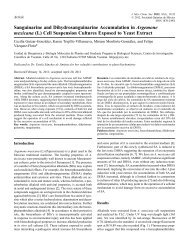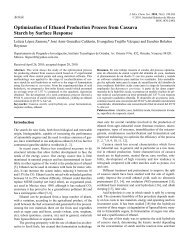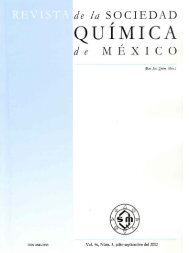SMQ-V047 N-002_ligas_size.pdf - Journal of the Mexican Chemical ...
SMQ-V047 N-002_ligas_size.pdf - Journal of the Mexican Chemical ...
SMQ-V047 N-002_ligas_size.pdf - Journal of the Mexican Chemical ...
You also want an ePaper? Increase the reach of your titles
YUMPU automatically turns print PDFs into web optimized ePapers that Google loves.
The Use <strong>of</strong> N,N’-Di[α-phenylethyl]-diamines as Phosphorylated... 129<br />
<strong>the</strong> 31 P NMR chemical shifts (∆δ) for <strong>the</strong> diastereomeric phosphonamides<br />
were observed, allowing accurate integration and<br />
quantitative determination <strong>of</strong> <strong>the</strong> diastereomeric ratios.<br />
Experimental section<br />
31P NMR spectra were measured on a Varian Mercury-200<br />
MHz spectrometer. <strong>Chemical</strong> shifts are given as δ values<br />
(ppm). All reagents were purchased from Aldrich <strong>Chemical</strong><br />
Co.<br />
General Procedure for Chiral Alcohol Derivatization<br />
In an NMR tube are placed with vigorous stirring 0.16 mmol<br />
<strong>of</strong> free diamine, 0.5 mL <strong>of</strong> CDCl 3 , 119 mg (0.80 mmol) <strong>of</strong><br />
diethylaniline, and 23 mg (0.16 mmol) <strong>of</strong> PCl 3 previously dissolved<br />
in 50 µL <strong>of</strong> CH 2 Cl 2 , affording <strong>the</strong> chlorodiazaphospholidine<br />
and <strong>the</strong> 31 P NMR spectra are recorded (Table I). Immediately<br />
after, 0.13 mmol <strong>of</strong> racemic secondary alcohols is<br />
added, and <strong>the</strong> resulting mixture is stirred for 30 minutes<br />
before 31 P NMR spectra are recorded at room temperature<br />
(Table 2).<br />
Acknowledgment<br />
We thank CONACyT for financial support (Projects No.<br />
32202-E and 33023-E, and Grants No. 91275 and 144937).<br />
References<br />
1. (a) For a detailed review, see: Parker, D. Chem. Rev. 1991, 91,<br />
1441-1457. See, also: (b) Dale, J. A.; Mosher, H. S. J. Am. Chem.<br />
Soc. 1973, 95, 512-519. (c) Pirkle, W. H.; Hoover, D. J. Top.<br />
Stereochem. 1982, 13, 263-331. (d) Benson, S. C.; Cai, P.; Colon,<br />
M.; Haiza, M. A.; Tokles, M.; Snyder, J. K. J. Org. Chem. 1988,<br />
53, 5335-5341. (e) Jursic, B. S.; Zdravkovski, Z.; Zuanic, M.<br />
Tetrahedron: Asymmetry 1995, 5, 1711-1716.<br />
2. (a) Uccello-Barreta, G.; Bernardini, R.; Lazzaroni, R.; Salvadori,<br />
P. Org. Lett. 2000, 2, 1795-1798. (b) Reymond, S.; Brunel, J. M.;<br />
Buono, G. Tetrahedron: Asymmetry 2000, 11, 1273-1278. (c)<br />
Alexakis, A.; Chauvin, A.-S. Tetrahedron: Asymmetry 2001, 12,<br />
1411-1416.<br />
3. (a) Verkade, L. D.; Quin, L. D. Phosphorus-31 NMR<br />
Spectroscopy in Stereochemical Analysis; VCH Publishers:<br />
Deerfield Beach, 1987. (b) See, also: Juaristi, E. Introduction to<br />
Stereochemistry and Conformational Analysis; Wiley: New<br />
York, 1991; pp 137-138. (c) Johnson, C. R.; Elliott, R. C.;<br />
Penning, T. D. J. Am. Chem. Soc. 1984, 106, 5019-5020. (d)<br />
Kato, N. J. Am. Chem. Soc. 1990, 112, 254-257. (e) Anderson, R.<br />
C.; Shapiro, M. J. J. Org. Chem. 1984, 49, 1304-1305. f) Hulst,<br />
R.; Kellogg, R. M.; Feringa, B. L. Rec. Trav. Chim. Pays-Bas<br />
1995, 114, 115-138.<br />
4. For excellent reviews, see: (a) Togni, A.; Venanzi, L. M. Angew.<br />
Chem., Int. Ed. 1994, 33, 497-526. (b) Bennani, Y. L.; Hanessian,<br />
S. Chem. Rev. 1997, 97, 3161. (c) Lucet, D.; Le Gall, T.;<br />
Miokowski, Ch. Angewandte Chem., Int. Ed. 1998, 37, 2580-<br />
2627.<br />
5. (a) Jaen, J. In Encyclopedia <strong>of</strong> Reagents for Organic Syn<strong>the</strong>sis,<br />
Paquette, L. A., Ed.; Wiley: New York, 1995, Vol. 5, pp 3427-<br />
3431. (b) Juaristi, E.; Escalante, J.; León-Romo, J. L.; Reyes, A.<br />
Tetrahedron: Asymmetry 1998, 9, 715-740. (c) Juaristi, E.; León-<br />
Romo, J. L.; Reyes, A.; Escalante, J. Tetrahedron: Asymmetry<br />
1999, 10, 2441-2495.<br />
6. Hulst, R.; de Vries, K.; Feringa, B. L. Tetrahedron: Asymmetry<br />
1994, 5, 699-708.<br />
7. (a) Alexakis, A.; Mutti, S.; Mangeney, P. J. Org. Chem. 1992, 57,<br />
1224-1237. (b) Alexakis, A.; Frutos, J. C.; Mutti, S.; Mangeney,<br />
P. J. Org. Chem. 1994, 59, 3326-3334. For o<strong>the</strong>r chiral derivatizing<br />
agents based on enantiopure trans-1,2-diaminocyclohexane,<br />
see: (c) Resch, J. F.; Meinwald, J. Tetrahedron Lett. 1981, 22,<br />
3159-3162. (d) Staubach, B.; Buddrus, J. Angew. Chem., Int. Ed.<br />
1996, 35, 1344-1346.<br />
8. Anaya de Parrodi, C.; Moreno, G. E.; Quintero L.; Juaristi, E.<br />
Tetrahedron: Asymmetry 1998, 9, 2093-2099.<br />
9. Mastranzo, V. M.; Quintero, L.; Anaya de Parrodi, C.; Juaristi,<br />
E.; Walsh, P. J. Unpublished results.




